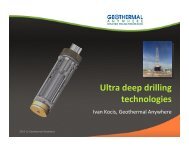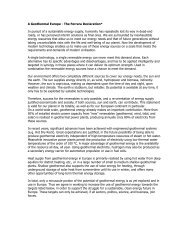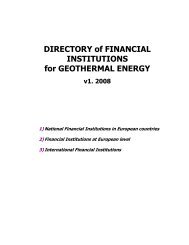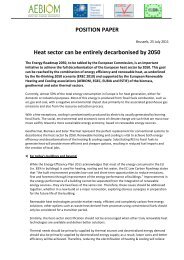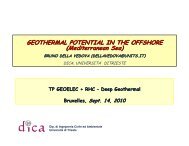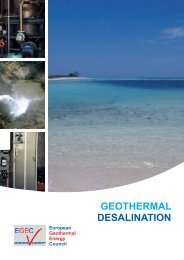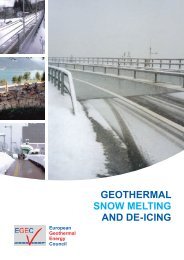4<strong>Strategic</strong> <strong>Research</strong> <strong>and</strong> <strong>Innovation</strong> <strong>Agenda</strong> <strong>for</strong> <strong>Renewable</strong> Heating & CoolingRHC applications <strong>and</strong> priorities <strong>for</strong> non-residential buildings4.1 Description of dem<strong>and</strong> characteristicsThis sector includes a wide range of public <strong>and</strong> private non-residential buildings, such asoffices, hotels, restaurants, shops, schools, universities, hospitals, data centres, swimmingpools <strong>and</strong> various other services.A recent study of the European Commission 51 estimated the annual dem<strong>and</strong> in the EU ofuseful energy <strong>for</strong> space heating <strong>and</strong> <strong>for</strong> hot water at around 56 Mtoe (2,284 PJ) <strong>and</strong> 17 Mtoe(625 PJ), respectively. The estimated useful cooling dem<strong>and</strong> is around 32 Mtoe (1,350 PJ)which represents only 30% of the total dem<strong>and</strong>. According to the PRIMES model (EC DG ENER,2010) the heating / cooling mix in the non-residential buildings will significantly change in thenext years, ending up to 52% heating <strong>and</strong> 48% cooling.In the services sector, the heating <strong>and</strong> cooling dem<strong>and</strong> is strongly influenced by the type ofbuilding <strong>and</strong> its use. The characteristics differ from that of the residential sector in the followingaspects:• Loads are typically higher than in the residential sector, starting with some 10 kW th<strong>for</strong> small businesses or offices, to 1 MW th or more <strong>for</strong> larger projects• Space cooling / air conditioning is almost a st<strong>and</strong>ard in this type of application, creatinga definite requirement <strong>for</strong> providing cooling from renewable sources• Forced ventilation is the norm in this type of buildings, resulting in a need <strong>for</strong> heating <strong>and</strong>cooling of ventilation• There is in most cases a high internal heat generation, mainly in shops (lighting, refrigeration,etc. 52 ), but also in other buildings (large number of persons, ICT-facilities, etc.)• Heating <strong>and</strong> cooling loads can vary widely in a short timeframe (conference rooms / theatre/ cinema, shopping or office hours, etc.)• In many cases, DHW heating is not required (or it is negligible); notable exceptions arehotels, hospitals, sports/recreational facilities, where a large <strong>and</strong> sudden dem<strong>and</strong> <strong>for</strong>DHW can occur (e.g. showering in the morning or after sports events)In consequence, the RHC technologies to cover this dem<strong>and</strong> must be rather flexiblein size, adaptive to quick changes, <strong>and</strong> able to supply substantial amounts of coolingto the buildings. The system concepts are more complex, with a combination of several heat<strong>and</strong>cold sources <strong>and</strong> distribution devices. Digital energy control systems ofbuildings are required <strong>for</strong> the optimum operation of these installations, both <strong>for</strong> com<strong>for</strong>t <strong>and</strong><strong>for</strong> efficiency reasons. On the other h<strong>and</strong>, professional operation <strong>and</strong> maintenance in thistype of application can be more easily guaranteed here than in the residential sector.4.2 Solar thermal technologiesIn general, the service sector requires larger solar thermal systems, which alloweconomies of scale but also imply customised planning. The complexity in the design<strong>and</strong> installation of such systems is higher. Moreover, safety requirements are more dem<strong>and</strong>ing,e.g. by dealing with steam in the system. The efficiency of the solar thermal systemdepends a lot on the dem<strong>and</strong> curve <strong>and</strong> the temperature requirements, e.g. solar thermalsystems are well suited to supply the high volume of hot water consumed during the wholeyear by hotels, hospitals <strong>and</strong> homes <strong>for</strong> elderly people.Most of the dem<strong>and</strong> <strong>for</strong> cooling in the service sector is currently supplied by electrical systems.Thermally driven cooling technologies constitute promising alternatives <strong>and</strong>are set to play a key role in the efficient conversion of energy in the field of building airconditioning<strong>and</strong> refrigeration, especially in southern Europe. Today, these technologies areused largely in combination with waste heat, district heat or co-generation units. Thermallydriven cooling cycles can be run with solar thermal energy too, thus producing solar airconditioning<strong>and</strong> refrigeration. In climates where cooling is not required all year round, thesesystems can be used <strong>for</strong> cooling in the summer season <strong>and</strong> <strong>for</strong> space heating in the heatingseason.51Pardo, N. et al (2012)52Some shopping malls donot have any heating dem<strong>and</strong>under normal operatingconditions, even in moderateclimate.42
<strong>Renewable</strong>Heating & CoolingEuropean Technology Plat<strong>for</strong>m4.2.1 <strong>Research</strong> <strong>and</strong> innovation priorities with impact in the Short TermR&D priorities <strong>for</strong> solar heating <strong>and</strong> cooling systems in non-residential buildingsaim at simplifying installation, improving integration, increasing stability, reliability<strong>and</strong> long-term per<strong>for</strong>mance. Enabling a higher share of solar collectors to be integrated intothe building envelope is also a priority. The improvement of thermally driven cooling componentsdeserves special attention.ST.6ObjectiveState-of-the-artTargetsType of activityMultifunctional building components, including façade <strong>and</strong> roof integrated collectors,<strong>for</strong> new <strong>and</strong> existing buildingsSolar thermal systems will be integrated into the building envelope by means of multifunctionalcomponents. Collectors, storage <strong>and</strong> other components will become structural elements fulfillingmultiple functions in the building, such as heat generation, storage <strong>and</strong> distribution as well asstatic function. They will optimise the use of passive <strong>and</strong> active solar energy in the building,generating heat, regulating the building temperature, distributing <strong>and</strong> storing heat <strong>and</strong> cold.Some building components will become itself part of the heating <strong>and</strong> cooling system, with improvedaesthetics <strong>and</strong> integration of multifunctional components fulfilling the requirementsof buildings regarding security <strong>and</strong> maintenance.Today, solar thermal system components are – as the heating <strong>and</strong> cooling equipment in general– separated from the building components. Only the concrete core activation <strong>for</strong> heat <strong>and</strong> colddistribution is increasingly used. The solar collector is usually installed with a small distance tothe roof tiles, however it is sometimes already integrated in the roof or in the façade with multiplefunctionality, such as insulation <strong>and</strong> protection against the weather elements. Some pilot installationshave been realised using prefabricated integrated solar façades, with a solar collector onthe outside, a heat distribution system on the inside <strong>and</strong> a heat store in between.Development of multifunctional solar elements, which will be used as building components,e.g. solar collectors as roof <strong>and</strong> façade elements <strong>and</strong> building walls as heat stores with multiplefunctionalities <strong>and</strong> high flexibility regarding the architectural integration available in the marketby 2020. Availability of prefabricated multifunctional solar façade systems <strong>for</strong> energy-relatedrefurbishment of existing buildings.20% <strong>Research</strong> / 50% Development / 30% DemonstrationST.7ObjectiveState-of-the-artHighly efficient solar assisted cooling systems combining heating <strong>and</strong> coolingThe main research regarding cooling components will focus on developing technical solutionsto make the systems more economically attractive <strong>and</strong> well per<strong>for</strong>ming on a long-term basis.For the first criteria, plug <strong>and</strong> function systems will be developed so as to decrease installationcost. These systems will require hydraulic configurations as simple as possible when at thesame time leading to very low primary energy consumption when coupled with back up.Specific building applications will be identified so as to maximise the solar energy usability allyear long as well on cooling as heating (space <strong>and</strong> DHW). Specific developments are expectedon the adaptation of solar system to low parasitic consumption through new heat rejectionconcepts <strong>and</strong> on system architecture leading to very low cost <strong>for</strong> operation <strong>and</strong> maintenance.Finally lots of ef<strong>for</strong>t should be devoted to the development of packaged solutions reducinginstallation hassle <strong>and</strong> increasing the level of st<strong>and</strong>ardisation of solar cooling systems,either they are small, medium <strong>and</strong> even large capacity.In 2011 about 750 solar cooling systems were installed worldwide, including installationswith small capacity (less than 20kW) 53 .Due to the large number of system components, i.e. cooling equipment, solar collectors<strong>and</strong> heat storage appliances, which are not optimized yet, the investment costs are high <strong>and</strong>solar thermal cooling systems are not yet cost-competitive with conventional electrically-drivencooling systems.TargetsType of activityOverall efficiency (in equivalent power consumption) of the solar system <strong>for</strong> heating<strong>and</strong> cooling of more than 10 (COP) <strong>and</strong> solar cooling system costs halved by 2020.30 % <strong>Research</strong> / 40% Development / 30% Demonstration53Mugnier & Jakob (2012).4.2.2 <strong>Research</strong> <strong>and</strong> innovation priorities with impact in the Medium <strong>and</strong> Long TermSolar thermal applications to the service sector have a significant potential in the Medium toLong Term. <strong>Research</strong> activities should focus on the following priorities:• Development of cost effective solar based hybrid systems <strong>for</strong> 100% renewableheat solutions (ST.8) leading to solar fractions above 50%. These system concepts areparticularly suitable to replace conventional heating systems of swimming pools, carwashfacilities <strong>and</strong> other application characterised by constant daily heat dem<strong>and</strong> through theyear with only week-end breaks.• <strong>Research</strong> on new absorption <strong>and</strong> adsorption chillers (ST.9). The per<strong>for</strong>mance ofsolar air conditioning <strong>and</strong> refrigeration systems can be increased considerably dueto higher temperature of heat rejection in new absorption <strong>and</strong> adsorption chillers,as well as new desiccant <strong>and</strong> evaporative cooling concepts (solid <strong>and</strong> liquid desiccantsorption systems).43



